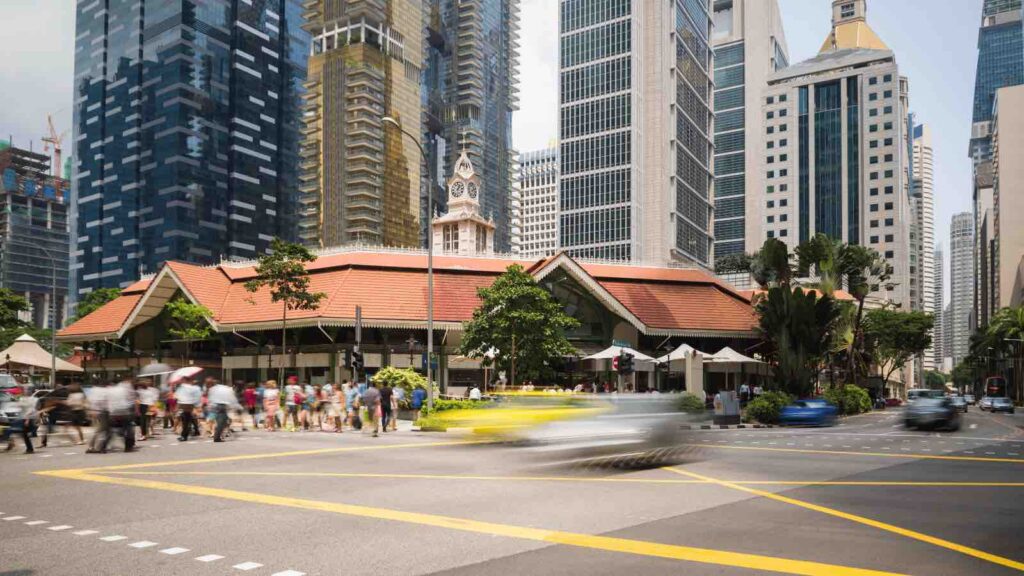Areas like Raffles Place, Shenton Way, Telok Ayer and Lau Pa Sat, known for their dense, skyscraper-laden landscapes, register temperatures up to 6 degrees Celsius higher than more suburban locales, the study reveals.
A recent study has spotlighted the varying temperatures across Singapore, pinpointing Telok Ayer as one of the city’s warmest areas, despite its greenery, low-rise architecture, and bay proximity. Surprisingly, the urban heart, encased by towering buildings, suffers from diminished coastal breezes, a finding by sustainable development experts Arup. The neighborhood’s dark terracotta roofs, though visually appealing, exacerbate the warmth, absorbing solar radiation and heating the vicinity.
RELEVANT SUSTAINABLE GOALS



The Urban Heat Island Effects, Singapore
Areas like Raffles Place, Shenton Way, and Lau Pa Sat, known for their dense, skyscraper-laden landscapes, register temperatures up to 6 degrees Celsius higher than more suburban locales, the study reveals. Arup’s comprehensive mapping, focusing on a 150 sq km area of Singapore’s urban core, employed advanced digital heat analytics to uncover these insights.
Industrial zones like Kampong Ubi, densely populated regions such as Rochor and Marine Parade, and sectors within Orchard and Sembawang also reported significant temperature disparities, exceeding a 5-degree Celsius difference from their surroundings.
Conversely, the study identified Upper Peirce Reservoir as Singapore’s coolest spot, where water and vegetation combine to create a climate approximately 6.5 degrees Celsius milder than the city’s hotspots.
This research extends beyond Singapore, comparing its findings with cities like Cairo, London, Los Angeles, Madrid, Mumbai, and New York, underscoring a stark contrast in vegetation coverage between the hottest and coolest areas.
Combatting Urban Heat: Arup’s Vision for Greener, Cooler Cities
Addressing the Urban Heat Island Effect, Dr. Shawn Lum of Nanyang Technological University suggests strategies such as enhanced tree canopy and reflective building surfaces to mitigate urban heat. However, he acknowledges the challenges and costs associated with retrofitting existing structures.
Arup, a leading global consultancy in sustainable development, highlights that neighborhoods like Telok Ayer and Raffles Place experience intensified heat due to minimal water presence and only 6% vegetation cover. These areas lack natural cooling elements, exacerbating urban heat.
Arup points out that Telok Ayer’s heat is further amplified by its urban environment. “The once coastal roads are now hemmed in by towering developments that obstruct sea breezes,” Arup notes. Additionally, “The area’s characteristic dark terracotta rooftops absorb substantial solar heat. This warmth is then transferred to the surrounding air, significantly affecting pedestrian-level temperatures in lower-rise areas,” Arup explains.
To mitigate urban heat, Arup advocates for key design interventions. These include expanding tree canopy coverage, enhancing ground permeability, and utilizing reflective materials for building roofs. Such strategies not only passively cool the environment but also reduce reliance on air conditioning, offering a sustainable path toward cooler cities.
Nature’s own cooling mechanisms, like the shade and transpiration from trees, coupled with Singapore’s thoughtful infrastructure planning, provide a solid foundation for combating urban heat, showcasing a commitment to a cooler, more sustainable urban environment.
Singapore is proactively seeking solutions to this urban warmth, aligning with the Singapore Green Plan 2030 through a digital urban climate study. The initiative aims not only to cool the city-state but also to offer insights applicable to similar climates, particularly in Southeast Asia.
You may also be interested in :
Singapore’s First Urban Fish Farm : Repurposing Shipping Containers For Sustainable Aquaculture



